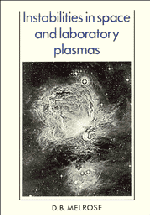Book contents
- Frontmatter
- Contents
- Preface
- Plasma formulary
- Part I Introduction to plasma theory
- Part II Instabilities in unmagnetized plasmas
- Part III Collision-dominated magnetized plasmas
- Part IV Instabilities in magnetized collisionless plasmas
- 10 Dispersion in a magnetized plasma
- 11 Electron cyclotron maser emission
- 12 Instabilities in warm and in inhomogeneous plasmas
- 13 Instabilities due to anisotropic fast particles
- Appendix A The plasma dispersion function
- Appendix B Bessel functions
- Appendix C Collision frequencies
- Appendix D Transport coefficients
- Bibliographical notes
- References
- List of commonly used symbols
- Author index
- Subject index
13 - Instabilities due to anisotropic fast particles
Published online by Cambridge University Press: 06 December 2010
- Frontmatter
- Contents
- Preface
- Plasma formulary
- Part I Introduction to plasma theory
- Part II Instabilities in unmagnetized plasmas
- Part III Collision-dominated magnetized plasmas
- Part IV Instabilities in magnetized collisionless plasmas
- 10 Dispersion in a magnetized plasma
- 11 Electron cyclotron maser emission
- 12 Instabilities in warm and in inhomogeneous plasmas
- 13 Instabilities due to anisotropic fast particles
- Appendix A The plasma dispersion function
- Appendix B Bessel functions
- Appendix C Collision frequencies
- Appendix D Transport coefficients
- Bibliographical notes
- References
- List of commonly used symbols
- Author index
- Subject index
Summary
Resonant scattering
The scattering rate due to Coulomb interactions between a fast particle (speed v) and thermal particles decreases with increasing v as v−3. Thus one might expect that fast particles are scattered very ineffectively. The reverse is the case in the low density (low β) plasmas in the magnetosphere, and in space and astrophysical plasmas generally. Fast particles are scattered very efficiently due to resonant interaction with low frequency waves, called resonant scattering.
The evidence which led to the initial development of the theory of resonant scattering came from the properties of the trapped particles in the magnetosphere. By the early 1960's it was clear that for the stability of the distributions of trapped magnetospheric particles (in the terrestrial ‘radiation’ or ‘van Allen’ belts) to be consistent with the observations of precipitation of these particles, both the fast electrons and the fast ions must be scattered very efficiently. The development of the theory of resonant scattering led to a satisfactory qualitative and semi-quantitative explanation for these magnetospheric observations. Resonant scattering also offered ways of resolving serious difficulties connected with the scattering and acceleration of fast particles in astrophysical plasmas. The most obvious of these concerns the confinement of galactic cosmic rays (§13.4). Another serious difficulty was with the acceleration of fast particles: early theories for the acceleration required (either implicitly or explicitly) very efficient scattering.
- Type
- Chapter
- Information
- Instabilities in Space and Laboratory Plasmas , pp. 233 - 251Publisher: Cambridge University PressPrint publication year: 1986
- 1
- Cited by



